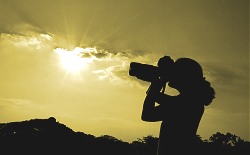 One of the most important elements of photography is the amount of light that is available for the pictures that are being taken. This is known as exposure. Exposure can significantly affect the appearance of the object or person you are trying to photograph. For example, a brightly lit background such as a sun filled sky can cause a vibrant subject to appear as just a black outline. For this reason, it is important to understand how you can adjust the exposure modes on your camera to take the best possible photograph.
One of the most important elements of photography is the amount of light that is available for the pictures that are being taken. This is known as exposure. Exposure can significantly affect the appearance of the object or person you are trying to photograph. For example, a brightly lit background such as a sun filled sky can cause a vibrant subject to appear as just a black outline. For this reason, it is important to understand how you can adjust the exposure modes on your camera to take the best possible photograph.
Many cameras today come with various auto exposure modes to help combat the issues that can be caused by varying light levels. In a standard camera the default exposure setting is usually referred to as the centre weighted average. This mode averages out the entire area of what you are photographing and tends to focus on subjects in the centre of the photograph.
Some of the other modes available for exposure on a quality camera are spot metering, multi spot metering and centre weighting. All of these settings are intended to assist you in finding the right exposure level for situation at hand. These modes can be used to help balance out skin tones, sunlight, shade or multiple people in a photograph. Be sure to test out each mode so you can begin to understand which one best fits the scene and area that you are photographing and therefore gives the highest quality picture.
Another way to tackle exposure difficulties is to set the exposure on your camera on your own. This option is known as manual exposure. While this option may be better suited for more experienced photographers who really understand the amount of light needed for a particular photograph, it can also be learned through trial and error.
One of the benefits of using a manual exposure mode is that the settings will stay the same even as you change the area or subjects that you are photographing. With automatic modes, the exposure will change even if you only slightly change the area you are photographing.
Learning how to manually set exposure levels can also assist you in balancing out differences in the subjects, such as photographing persons that are wearing both dark and light clothing. A manual setting will stop the settings automatically changing as the camera tries to adjust to the colour differences in the clothing.
Understanding the amount of light that is exposed to the camera is generally related to four items. The most obvious of those is the light that is provided from the background that you are photographing. However, the shutter speed (the length of time the shutter is open), aperture setting (the dimension of the outlet where light is able to come in) and ISO speed (the sensitivity level of the light sensor) also affect it as well. Together, all of these elements determine what type of exposure is best for the image that you are trying to capture. Play around with adjusting all of them and you will soon work out the best combination for the photos you are wanting to take.





Hi my loved one! I want to say that this post is
awesome, nice written and come with approximately
all significant infos. I’d like to peer extra posts like this .
I think this is among the most vital information for me.
And i am glad reading your article. But wanna remark
on few general things, The web site style is great, the articles is
really excellent : D. Good job, cheers
Attractive component of content. I just stumbled upon your
site and in accession capital to assert that I acquire actually loved account
your blog posts. Anyway I’ll be subscribing to your feeds and even I fulfillment you access persistently fast.
I don’t even know how I ended up here, but I thought this Cheers!
Cheers!
post was great. I don’t know who you are but certainly you’re going to a famous blogger
if you are not already
This website was… how do I say it? Relevant!! Finally I’ve found something which helped me.
Thank you!